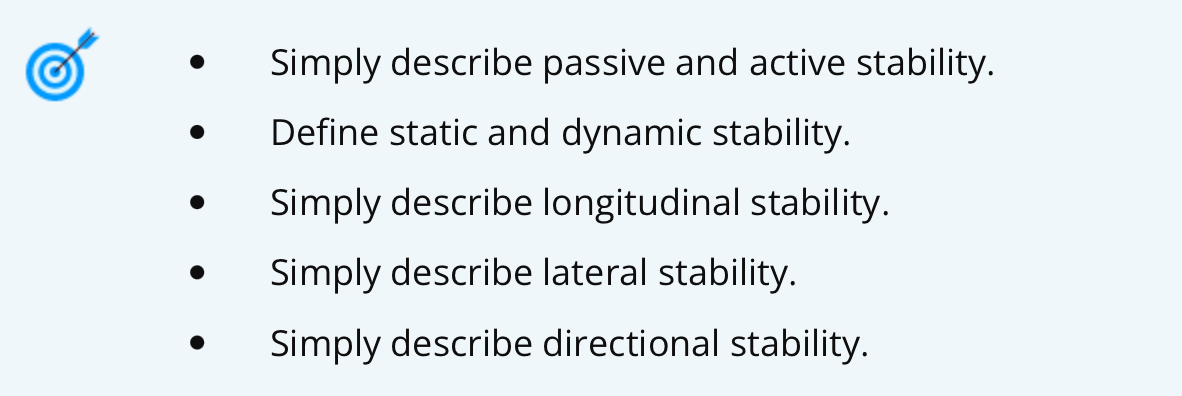module 8 target summaries
1/25
There's no tags or description
Looks like no tags are added yet.
Name | Mastery | Learn | Test | Matching | Spaced |
|---|
No study sessions yet.
26 Terms


.
Passive is the natural features, active is the purposeful inputs.
Static vs dynamic stability -
static is how the aircraft initially reacts after disturbance, positive means that it will return to original attitude, neutral means it will stay in new attitude, and negative means it will drift further away from original.
Dynamic means how the aircraft the. Acts over time after disturbance, positive meaning oscillations dampen, neutral meaning they stay the same, and negative means the worsen
Longditunal stability - lateral axis, pitch, controlled by elevators
Lateral stability - long axis, roll, aileron control
Directional stability - vertical axis, yaw, rudder control

.
.

.
Boundary layer - thin layer of stagnant air on a surface formed due to friction.
Upwash is air being pulled upward and over the low pressure side of wing
Downwash is air being pulled downward after the trailing edge
Laminar and turbulent flow - laminar is orderly and uniform, but easily disturbed and can separate easily, turbulent is chaotic flow with higher drag, however better stickiness and can help against stalling
Stagnation point is a point where airflow goes to 0 in speed, and static pressure = total pressure, can happen on leading edges, pitot tubes
Vortices form on the wingtips, due to interaction between low and high pressure air
What is chord line?
The straight line between the leading and trailing edge.
What is chord ?
The length of the chord line
What is camber?
The curvature of the wing, the difference between the chord and camber line.
What is the fineness ratio ?
The ratio of chord line, to the max thickness of the wing.
What is the aspect ratio ?
Aspect ratio is the ratio between mean chord and the wingspan, high aspect ratio means good lift with little drag, but low manoeuvres, where as low aspect ratio leads to higher drag but great manoeuvres
What is wash in wings?
Where the wing tips curve
What is wash out?
Wash out is where the roots of the wings are more curved.
What is AOA vs AOI ?
Angle of attack is the angle between the relative airflow and chord line, whereas the angle of incidence is the angle between the chord line and the relative airflow.
What is CP?
Centre of pressure, where all the lift or drag is said to act from on a wing
What are the 4 main type of wing shape ?
Elyptical - stall is consistent throughout wing i think
Rectangular - roots stall first
Swept - tips stall first
Tapered - tips stall first
What is dihedral vs anhedral ?
Dihedral - common in aviation - wingtip higher than root for rotational stability
Anhedral - common in military - wingtip lower than rot gives better agility
What is induced drag?
Induced drag is just an unavoidable big product of producing lift, it occurs due to things like vortices, downwash etc that create forces that are going to act against the direction of flight.
What are the 3 types of parasite drag?
Form
Interference
Friction
What is form drag?
Form drag is solved by streamlining, it occurs due to pressure differences but can be solved by streamlining, blunter = more form drag
What is interference drag?
Interference drag occurs due to multiple components correcting, and is solved by fairings, more pointy edges and corner will lead to more interference drag, but smoother transitions between components solves
What is friction drag?
Friction drag is created by skin friction ie air rubbing on surfaces.
What is compression drag?
Compression drag is created by supersonic shockwaves causing flow sepation
What is total drag ?
Total drag is parasite + induced

factors include - range, payload, rate of climb, cruise alt and speed, fuel economy, take of and landing requirements, manoeuvrability
steady state flight is where all forces are balanced.

glide ratio = how far forward/alt lost
glide ratio isnt affected by weight, the time will change with wieght only,

the forces acting in a turn are
vertical component of lift, which is opposing weight, and providing lift
horizontal component of lift - the force causing directional change i.e Turing the aircraft
centrifugal force - the apparent force, opposing the turn acting away from the centre of the turning circle
